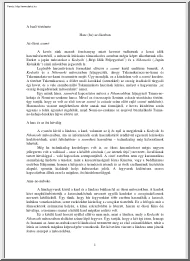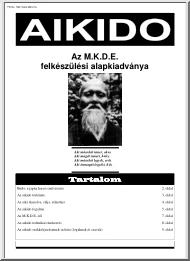Datasheet
Year, pagecount:2007, 1 page(s)
Language:English
Downloads:2
Uploaded:July 11, 2019
Size:618 KB
Institution:
-
Comments:
Attachment:-
Download in PDF:Please log in!
Comments
No comments yet. You can be the first!Most popular documents in this category
Content extract
Source: http://www.doksinet MARTIAL MINDS lye’s law with William Lye Martial Arts Brands Brand-awareness is pivotal to your dojo or martial arts style being considered by potential students. B big businesses recognise the power of brands. They are often a company’s most valuable asset. So I ask martial arts teachers, how have you developed, strengthened, defended and managed your ‘brand’ of martial art? In previous columns, I discussed setting up a martial arts business, and the various legal concepts underpinning the intellectual property of the martial arts. But what about the branding of your martial art? The notion that there’s no such thing as having a brand of martial art is misconceived, because many people equate brands to a product or service. In fact, often it is the buyers’ identification with the attitude or feeling the brand and its slogans project, that makes them want to buy the product, rather than the product itself. So, how do you develop your
‘brand’ of martial arts? Aaker(1) suggested a model of brand equity, which includes developing brand awareness and brand image. The latter is the anchor to which potential martial arts students would like to associate themselves. It’s the familiarity or liking of your brand or martial arts style, and signifies substance and a commitment to support it. In developing brand image, instructors ought to consider not only creating attributes, benefits and philosophies that would be embraced, but to strengthen the brand image by having appropriate legal protection in place. This is to ensure the uniqueness of your brand association is protected, when competing with others in the martial arts marketplace. Measures like trademark protection, copyright notices on all your written material (including online) would promote favourable associations with your brand of martial arts. Brand awareness is the ability to recall and recognise your offering. A good name is priceless and in the
martial arts industry, reputation GETTY IMAGES Bruce Lee: the most recognised martial arts ‘brand’ 20 BLITZ Magazine is vital. Given the ease with which one could just set up a dojo and begin teaching, the power of brand reputation is critical in distinguishing the great from the good and from the bad. One only needs to think about Bruce Lee, and his art of Jeet Kune Do springs to mind. Arguably, the name Bruce Lee is also a brand a great brand, as it has very strong brand imagery and awareness. Today, brand awareness is a very valuable asset. The name Gracie is generic of Brazilian Jiu Jitsu; Mas Oyama of Kyokushin karate; Muhammad Ali of boxing, etc. Developing sound brand image and brand awareness is the foundation for cultivating strong brand loyalty. When you’ve spent time and resources setting up the legal structure to protect your intellectual property, you want to keep the loyal following of your students, otherwise your brand becomes worthless. Brand loyalty also
provides you with time to respond to competition. Some might conclude that martial arts is no longer just about taking a journey of enlightenment; it’s now a big business, ranging from providing school students with basic knowledge of selfdefence and confidence, to reallife solutions to physical threats. With the proliferation of reality based self-defence and the like, the aperture of traditional martial arts is getting smaller. However, these newer forms of self-defence lack the kind of brand image and brand awareness that traditional martial arts styles have developed. Consistently maintaining a good brand loyalty isn’t easy, but if you treat your students correctly, stay abreast of their needs, constantly measure and manage their level of satisfaction with their learning and progress, and provide additional training and resources for growth, they will stay with you. So, think about the name, the symbol/logo and the slogan of your martial art ‘brand’. Names are important,
and you begin by protecting them either by trade mark protection, business name and/or company name registration, and by using them consistently in the marketplace. If you do nothing, your competitors might prevent you from doing something in the future if they use the brand you created, but never legally protected. Finally, it would be remiss of me not to state that having a strong martial arts brand doesn’t necessarily mean you deliver the best martial arts. Reputation really comes down to the customers’ perception of the overal quality or superiority of your martial arts instruction. If, however, you achieve for the students what they perceive to be the intended objective of the training, then you have gone a long way to building brand image and awareness among your students. REFERENCES: 1. Aaker, DA, Managing Brand Equity: Capitalising on the Value of Brand Names, The Free Press, NY, 1991. William Lye has been a practising Barrister at Law for 19 years. He can be contacted at
wemlye@foleys.comau www.sportzblitznet
‘brand’ of martial arts? Aaker(1) suggested a model of brand equity, which includes developing brand awareness and brand image. The latter is the anchor to which potential martial arts students would like to associate themselves. It’s the familiarity or liking of your brand or martial arts style, and signifies substance and a commitment to support it. In developing brand image, instructors ought to consider not only creating attributes, benefits and philosophies that would be embraced, but to strengthen the brand image by having appropriate legal protection in place. This is to ensure the uniqueness of your brand association is protected, when competing with others in the martial arts marketplace. Measures like trademark protection, copyright notices on all your written material (including online) would promote favourable associations with your brand of martial arts. Brand awareness is the ability to recall and recognise your offering. A good name is priceless and in the
martial arts industry, reputation GETTY IMAGES Bruce Lee: the most recognised martial arts ‘brand’ 20 BLITZ Magazine is vital. Given the ease with which one could just set up a dojo and begin teaching, the power of brand reputation is critical in distinguishing the great from the good and from the bad. One only needs to think about Bruce Lee, and his art of Jeet Kune Do springs to mind. Arguably, the name Bruce Lee is also a brand a great brand, as it has very strong brand imagery and awareness. Today, brand awareness is a very valuable asset. The name Gracie is generic of Brazilian Jiu Jitsu; Mas Oyama of Kyokushin karate; Muhammad Ali of boxing, etc. Developing sound brand image and brand awareness is the foundation for cultivating strong brand loyalty. When you’ve spent time and resources setting up the legal structure to protect your intellectual property, you want to keep the loyal following of your students, otherwise your brand becomes worthless. Brand loyalty also
provides you with time to respond to competition. Some might conclude that martial arts is no longer just about taking a journey of enlightenment; it’s now a big business, ranging from providing school students with basic knowledge of selfdefence and confidence, to reallife solutions to physical threats. With the proliferation of reality based self-defence and the like, the aperture of traditional martial arts is getting smaller. However, these newer forms of self-defence lack the kind of brand image and brand awareness that traditional martial arts styles have developed. Consistently maintaining a good brand loyalty isn’t easy, but if you treat your students correctly, stay abreast of their needs, constantly measure and manage their level of satisfaction with their learning and progress, and provide additional training and resources for growth, they will stay with you. So, think about the name, the symbol/logo and the slogan of your martial art ‘brand’. Names are important,
and you begin by protecting them either by trade mark protection, business name and/or company name registration, and by using them consistently in the marketplace. If you do nothing, your competitors might prevent you from doing something in the future if they use the brand you created, but never legally protected. Finally, it would be remiss of me not to state that having a strong martial arts brand doesn’t necessarily mean you deliver the best martial arts. Reputation really comes down to the customers’ perception of the overal quality or superiority of your martial arts instruction. If, however, you achieve for the students what they perceive to be the intended objective of the training, then you have gone a long way to building brand image and awareness among your students. REFERENCES: 1. Aaker, DA, Managing Brand Equity: Capitalising on the Value of Brand Names, The Free Press, NY, 1991. William Lye has been a practising Barrister at Law for 19 years. He can be contacted at
wemlye@foleys.comau www.sportzblitznet





 When reading, most of us just let a story wash over us, getting lost in the world of the book rather than paying attention to the individual elements of the plot or writing. However, in English class, our teachers ask us to look at the mechanics of the writing.
When reading, most of us just let a story wash over us, getting lost in the world of the book rather than paying attention to the individual elements of the plot or writing. However, in English class, our teachers ask us to look at the mechanics of the writing.